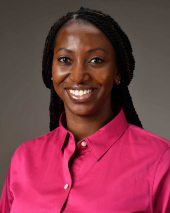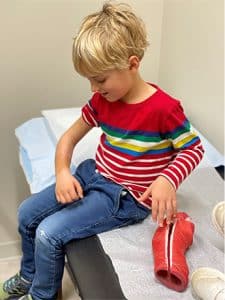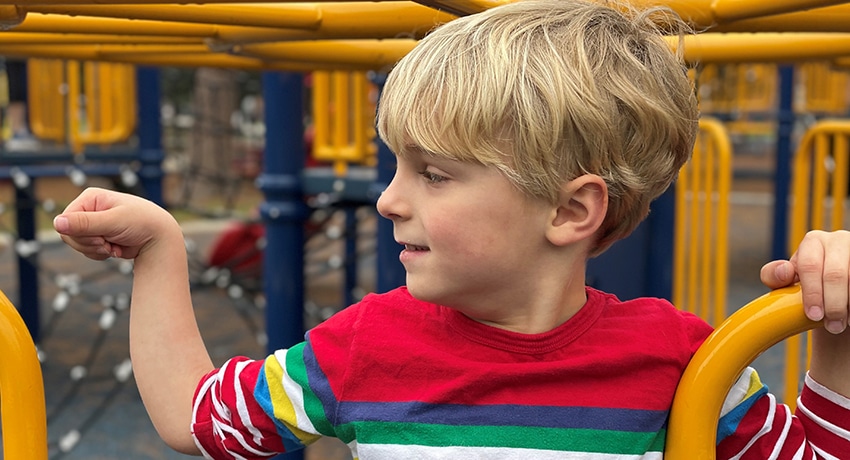Like many children his age, 6-year-old Randy* of Houston loves to run. Yet two accidental falls led him to break his right forearm two times in less than five months.
Today Randy’s limb is whole again. Incredibly, the young patient did not need to undergo surgery thanks to expert orthopedic care and natural youth repair!
Spring break
Randy first broke his right forearm in March 2022 during a Spring Break road trip.
“We were eating at a restaurant in Austin that had green space,” Randy’s mother said. “He was playing chase with his sister, and he tripped over a rooty area at the edge of the garden. He fell onto the concrete hands first.”
Randy’s parents were unsure of the severity of his injury as there were no obvious signs of a break. They waited less than an hour before taking him to the emergency room.
“He’s our ‘tough guy,’ but he continued to cry for a good 40 minutes. He also started to shake from the pain,” his mother said. “We knew something was wrong and took him to the hospital. We learned he broke his radius and ulna in his right forearm.”
Randy received follow-up care at a Houston hospital and wore a cast for six weeks. His forearm healed as expected. Little did anyone know that another cast was coming.
Summer break
In August 2022, Randy tripped again. This time, he was at home.
“It was just a normal Monday night. It was time for bed, and Randy ran up the stairs. All of a sudden I heard this crash and thud, and a scream that I’ve never heard in my life,” his mother said.
Randy tripped over the family dog who was lying on the platform of the stairs. The fall caused him to crack his bones again.
“The bone in his right forearm was protruding,” his mother said. “That same arm snapped like a pencil this time. It was like a noodle when we took him to the hospital.”
Lucky break

After he was treated at the hospital, Randy’s mother wanted him to receive follow-up care from a specialist. That is when a neighbor recommended Angie L. Curtis, MD, pediatric sports medicine physician with UT Physicians.
“I was looking for a pediatric orthopedist to make sure he didn’t need surgery,” his mother said. “My friend couldn’t say more amazing things about Dr. Curtis. She didn’t have to tell me twice. I set the appointment, and Dr. Curtis was able to see him four days later.”
Curtis checked her patient’s forearm and the setting of his bones. She did not believe surgery was necessary. She then had Randy’s forearm set in a cast in time for the weekend.
Break point
Forearm fractures are common in children and account for at least 40% of all childhood fractures.
“What made his case stand out was that it was a refracture,” Curtis said. “Both of the bones in his forearm, the radius and ulna, were broken in the middle and in the exact same place. And this was the second time it happened in less than a year.”
According to Curtis, there is a higher risk of refracture the first three months after a bone heals.
“Randy was still in that high-risk period when he broke his arm again,” she said. “He was quite unlucky in that regard.”
Randy broke his forearm both times during a fall. This is not unusual, the doctor explained.
“A big reason for broken wrists and arms is that when we fall our arms go out first. This instinct is called protective extension,” Curtis said.
Break through

Children more likely to suffer from fractures rather than sprains.
“A kid has many open growth plates, and cartilage is not as strong as bone. My patients are more likely to have fractures before sprains,” Curtis said. “Some parents worry that their kid has brittle bones, but their injuries are more likely due to skeletal immaturity.”
Children are more likely to suffer breaks, but they are also more likely to heal from them faster and with little or no deformity.
“The good thing about a big injury in a young kid is that the body will remodel. Kids have the ability to remodel their bones because they’re still growing,” Curtis said. “We don’t get passes like that as adults.”
Though Randy’s right forearm has healed, it still has a slight bend. His body will naturally correct this, Curtis assured.
“He has a little bit of deformity from the initial fracture, a crooked area in his arm. But that’s the part that remodeling will take care of and straighten out over time,” Curtis said. “He has so much growth potential left that the small deformity won’t have a long-term effect on him.”
Break over
Randy’s mother cannot thank Curtis enough. She is grateful for the timely, expert care her son received as well as “the talk” he received.
“He never stops moving. He never stops running,” Randy’s mother said. “You can tell your kid a million times to stop doing something, but when a doctor tells them it’s pretty cool.”
When the cast was removed, Curtis asked Randy to try and be more careful.
“Dr. Curtis asked him to think before he acted because the next time he broke his arm he would need to have surgery to fix it,” his mother said. “It looked like he finally understood, and I appreciated that so much.”
*Name has been changed



